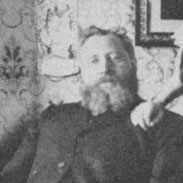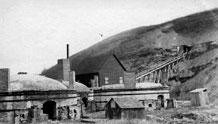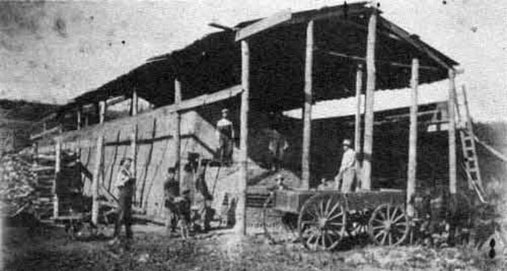|
One
of Hartney’s most important early industries, and arguably the one with
the greatest legacy, was brick-making. And its most important
practitioner was William Kirkland. William Kirkland (1852-1956) was
actually the third individual who developed a brick operation near
Hartney.
On the frontier of a new country, and in a place like Hartney, men like
William Kirkland were the powerful and vivid local expressions of
can-do optimisim, and of dreams made solid. They looked for the main
chance, and sometimes found it. By the few accounts we have, a man like
William Kirkland was probably determined, persuasive, dogged and proud.
And as the operator of an important brick operation be must also have
been organized, resilient, exacting, steady and patient. He was
certainly of a type, and a model of the era: a hands-on industrialist
with real skills and craftsmanship.
And from his brick operations, he was also probably rich. At the height
of his ten years of brick-making, in 1913, he was firing bricks for the
new Saskatchewan Legislative Building – at least 10 million of them.
And even discounting for such a large job (bricks usually sold for
$8/1000), and of the costs of business, it is likely that he made at
least $80,000. It was certainly enough to allow him to build a grand
house at the north end of town, with a prominent and stately view into
the community. It was, of course, of brick.
Brick
Making in Hartney
Hartney’s brick operations functioned for 20 years, between 1895 and
1913, and were key players in the local economy, providing employment,
products and helping to put the town on the map.
The three Hartney operations—Payne’s, Sackville’s and
Kirkland’s—describe the typical range of brick operations in rural and
small-town Manitoba, with the Payne and Sackville yards on the small
side and the Kirkland operation (the successor to Sackville) on the
larger side.
Hartney’s first brick-making operation, undertaken by Harry Payne,
began in 1895, just west of Hartney. Payne fired two kilns that first
year, with a final kiln of 150,000, typical for a small farm-type
operation. Payne sold some of this first stuff to W. Hopkins for his
new store, and was also shipping to many other places in southwest
Manitoba. Payne’s brick sold for $8/1000, a typical price for the
period. Payne’s reddish bricks were used in many local buildings, but
by 1902 the operation was gone, either having depleted the clay bed or
succumbing to the local competition. But even so, by the end of his
time, which lasted seven years, the operation had put out at least
3,500,000 bricks.
George Sackville opened his operation in 1898, and called it the
Hartney Brick and Delft Company. Located east of town, the operation
produced what was called a white brick (actually the buff colour we
think of). Sackville burned his first kiln in July and the last in
November of that first year, and continued for three years to ship
brick over the Northern Pacific and Manitoba Railway line to points
throughout southern Manitoba.
William Kirkland, who had worked for Sackville since 1899, took over
that yard in 1901. Kirkland`s first kiln of 80,000 bricks was burned in
May of 1902, and the lot went into the new A.E. Hill and Company
building then under construction. In May of 1905 the Star commented on
the “fine and inexhaustible deposit of clay” that was being worked by
Kirkland’s steam brick machine. A 1907-1908 Dominion Government report
on the Kirkland yard found that it sat on 15 acres and produced 30,000
bricks per day, with 10 men employed. The 1907 output was said to be
one million bricks. The operation’s last commissions came in 1913-14,
and were whoppers, with millions of bricks shipped to Regina for use in
the new Legislative Building.

Harry Payne, was also a stonemason and
carpenter.
The
Small Manitoba Brick Yard
Manitoba is geologically blessed with thousands of clay deposits,
hundreds of which have been exploited over the past 150 years for brick
manufacture. The “Golden Age” of this aspect of Manitoba’s building
history was from 1880 to 1912, the period when Hartney’s operations
flourished.
Manitoba brick operations varied greatly in size, productivity,
quality, sophistication and longevity. Research by the Province’s
Historic Resources Branch (HRB) reveals that there were about 60 major
clay sites and about 175 brick manufacturing plants that provided the
billions of bricks that were required for Manitoba’s major building
boom of the late 19th and early 20th centuries. That research also
reveals that William Kirkland’s was an important site, one of 12 of its
size and duration outside Winnipeg, St. Boniface and Portage la
Prairie, the major centres for brick manufacture in this province.
Information on brick manufacture in Manitoba is sketchy (the details of
industrial operations were not often covered in local newspapers) and
so it is only possible to provide a sense of typical operations based
on imaginative extrapolation of information from the HRB report.
First off, the work was hard. That probably goes without saying in the
late 1800s and early 1900s, when even with steam and horse power there
was still a large measure of manual labour. And it was long – 10 hour
days. The pay was modest, about $2/day, but it was steady, at least for
the duration of the season, usually from May (when the frost left) till
August or September.
Even small yards had up-to-date technologies, at least for the
brick-forming part of the operation. Steam-powered brick-makers often
turned out 15 to 20,000 bricks per day and therefore about 100,000 in a
week. A major physical aspect of a typical operation featured the large
covered drying sheds that new bricks were laid into.
It was the final stage of the brick-making operation that usually
distinguished a major from a minor yard: whether the brick was fired in
a scove or beehive kiln. It is almost certain that all of the Hartney
operations employed the scove kiln, a less sophisticated technology,
but one that was still effective enough to produce good quality brick.
Burnings lasted about seven to eight days, and when the outer shell of
bricks on a scove kiln was removed, workers discarded the disfigured
and discoloured bricks nearer the fire source. The remainder were set
into wagons for distribution to building sites, for transport on rail
lines, or for sale at the brickyard site.
There is nothing left of pits and operations of Hartney’s old
brickyards, not even photographs. But of course the many buildings
constructed with Hartney bricks are still here, and in each of them and
in every brick is a strong and enduring reminder of the toil, the
craftsmanship and of the very soil of Hartney, put up for the ages.

Brick drying sheds at the Wilson Brick Yard
near Gladstone, ca, 1898.
|

A typical scove kiln from the Leary Brick Yard
near Carman, 1895.
|

Beehive kilns at the La Riviere Brick Yards, one of
Manitoba’s major brick factories of the early 1900s.
|





